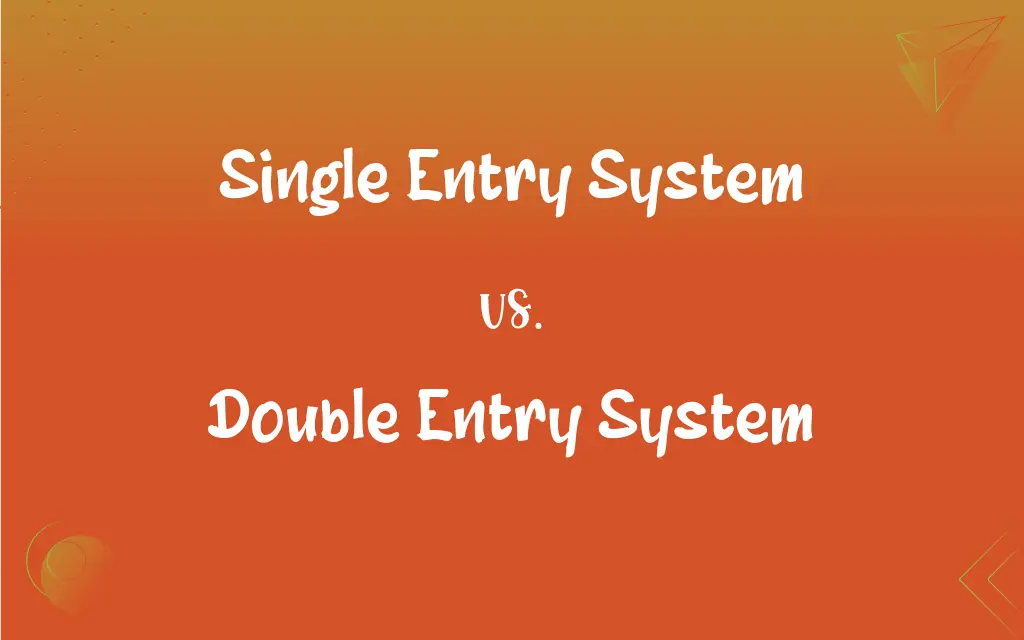Single Entry System vs. Double Entry System: What's the Difference?
Edited by Janet White || By Harlon Moss || Updated on October 21, 2023
Single entry system records one aspect of a transaction; double entry system records both debit and credit for every transaction.

Key Differences
The single entry system is a simplified accounting method where each transaction impacts only one account. This approach typically registers transactions in a primary ledger, often neglecting the corresponding opposite entry. In contrast, the double entry system mandates that each transaction affects two accounts, ensuring one debit and one credit in equal amounts.
In the single entry system, businesses often maintain only revenue and expense accounts, possibly supplemented with a record of withdrawals and cash. It’s frequently adopted by small businesses and sole proprietorships due to its simplicity. However, the double entry system offers a more comprehensive view, as it involves recording both the source and the use of funds. This system helps in maintaining the accounting equation: Assets = Liabilities + Equity.
Utilizing the single entry system might be straightforward, but it doesn’t provide a complete picture of a company's financial position. There’s no way to ascertain the accuracy of accounts or track assets and liabilities comprehensively. On the other hand, the double entry system provides a balanced view of financial operations, with every debit having a corresponding credit, making errors more identifiable.
Adopting the single entry system can pose challenges during audits due to its lack of systematic record-keeping. Conversely, the double entry system enhances transparency, facilitating easier financial analysis and audits. This system, being more structured, is preferred by larger corporations and is universally recognized.
While the single entry system might be suitable for small-scale operations with fewer transactions, the double entry system is indispensable for businesses seeking rigorous financial reporting and accountability. It ensures that the accounting equation remains balanced, reflecting true financial standing.
ADVERTISEMENT
Comparison Chart
Recording of Transactions
Registers only one side of the transaction.
Records both debit and credit aspects.
Completeness
Provides a partial financial picture.
Offers a comprehensive financial view.
Error Detection
Difficult to identify discrepancies.
Easier to detect errors due to balancing nature.
Suited For
Small businesses and sole proprietorships.
Larger corporations and formal accounting.
Financial Statements Generation
Limited capability due to incomplete data.
Can generate complete financial statements.
ADVERTISEMENT
Single Entry System and Double Entry System Definitions
Single Entry System
An informal accounting practice suitable for small businesses.
As her craft store expanded, she transitioned from the single entry system.
Double Entry System
An accounting method recording both debit and credit of transactions.
Public corporations typically adopt the double entry system for financial transparency.
Single Entry System
A system primarily tracking revenues and expenses.
His cafe's single entry system only noted sales and purchase details.
Double Entry System
A method aiding in error detection due to its balanced nature.
Discrepancies were quickly spotted thanks to the double entry system.
Single Entry System
An accounting method registering one aspect of a transaction.
Many freelancers use the single entry system due to its straightforward approach.
Double Entry System
A structured approach preferred for comprehensive accounting.
With the double entry system, every financial activity was meticulously recorded.
Single Entry System
A system often lacking a systematic ledger approach.
Financial analysts found it challenging to assess data from the single entry system.
Double Entry System
A system ensuring the accounting equation remains balanced.
The double entry system showed that their liabilities equaled assets minus equity.
Single Entry System
A method not providing a full account of assets and liabilities.
With only the single entry system, the firm's total assets remained uncertain.
Double Entry System
A universally recognized system promoting financial accountability.
To attract investors, the startup shifted to the double entry system.
FAQs
What is the key feature of the single entry system?
It records only one side of the transaction.
How does the double entry system enhance accuracy?
Every debit has a corresponding credit, ensuring a balanced account.
Is the single entry system standardized?
No, it often varies based on individual business preferences.
Can the single entry system generate a balance sheet?
It's challenging due to the system's incomplete data on assets and liabilities.
Why is the double entry system more suitable for audits?
It offers a comprehensive and transparent financial record.
Can the single entry system support growth and expansion?
It might be limiting for growing businesses needing detailed financial data.
Do financial institutions prefer businesses using the double entry system?
Generally, yes, as it offers detailed and transparent financial data.
Is the double entry system more error-prone due to its complexity?
Contrarily, its balanced nature makes error detection easier.
Is transitioning from single to double entry challenging?
It requires reorganization and possibly professional assistance, but it’s feasible.
How does the double entry system support the accounting equation?
It ensures Assets = Liabilities + Equity through balanced entries.
Why might a small business prefer the single entry system?
It’s simpler and requires less time for bookkeeping.
Which system provides a clearer view of profitability?
The double entry system, with its detailed accounts, offers a clearer view.
What's a primary challenge of the single entry system?
It lacks a systematic approach, making financial analysis challenging.
Can the double entry system be self-taught?
While possible, professional guidance ensures proper understanding and application.
Why is the double entry system widely accepted globally?
It offers rigorous financial reporting and accountability.
Is software available for the single entry system?
Yes, several basic accounting software support the single entry system.
Why might a business transition from single to double entry?
Growing transaction volume and need for detailed accounting may necessitate the shift.
Is the single entry system more cost-effective?
Initially, yes, due to its simplicity. But it might entail costs in the long run due to its limitations.
Are there hybrid systems combining both methods?
Some businesses might adopt a semi-double entry system, but it’s not a standard practice.
Which system is older historically?
The double entry system dates back to the Renaissance and is older in formal practice.
About Author
Written by
Harlon MossHarlon is a seasoned quality moderator and accomplished content writer for Difference Wiki. An alumnus of the prestigious University of California, he earned his degree in Computer Science. Leveraging his academic background, Harlon brings a meticulous and informed perspective to his work, ensuring content accuracy and excellence.
Edited by
Janet WhiteJanet White has been an esteemed writer and blogger for Difference Wiki. Holding a Master's degree in Science and Medical Journalism from the prestigious Boston University, she has consistently demonstrated her expertise and passion for her field. When she's not immersed in her work, Janet relishes her time exercising, delving into a good book, and cherishing moments with friends and family.































































